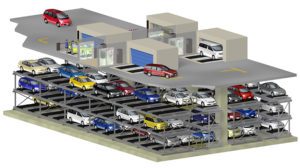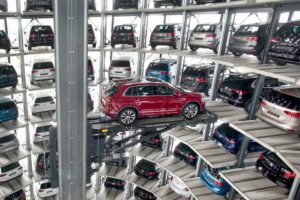Protecting the Future of Parking
What is Mechanically Accessed Enclosed Parking?
Mechanically accesses enclosed parking are structures where cars are stacked vertically to limit space. The designs of these unique systems help transport vehicles from the entrance to its parking space without the driver present. In addition to the automatic parking system, these vertical parking structures are also known by several other names:
Robotic parking garage
Car parking system
Automated parking facility
Automated vehicle storage and retrieval system
Mechanical accesses parking
How do they work?
Drivers take their cars to the entrance of the mechanically accessed parking where all occupants exit the vehicle. From here, the vehicle is moved by mechanical maneuvers to an available space where it is automatically parked or parked by an attendant.
What is the history of mechanically accessed parking?
The invention of mechanically accessed parking helped to solve parking issues in areas where space was already minimal, like cities and heavily populated areas. The first instance when mechanically accessed parking was used was in Paris, France in 1905. Called the “Garage Rue de Ponthieu,” it had elevators that transported unaccompanied cars to an upper deck. An attendant would then drive the car to an empty parking space on that deck.
Automatic parking further developed in the 1920s when a Ferris-wheel design became a popular mode for automatic parking with limited space. This French design called “paternoster” made it possible for eight cars to fit in each compartment, maximizing the number of vehicles that could be parked while minimizing space. In the 1950s, Washington D.C. became the home to the first driverless parking garage, where mechanical maneuvers transported cars. Today, these type of parking systems are becoming more and more prevalent throughout the U.S and abroad.
Image courtesy of www.web-japan.org
What are the benefits of mechanically accessed parking?
- More cars fit in a compact area: They are beneficial because they help save space. This is especially true in the case of fully automatic parking systems, where attendants do not have to park cars. This means that each vehicle can be parked closer to one another because no one will have to get out of their cars.
- Limits construction costs and time: Mechanically accessed parking limits the time, money, and resources that construction companies would typically spend when working to create a fully functioning parking garage. In normal parking garages, construction crews must consider stairwells, pedestrian walkways, exit routes, elevators, and even the height of the ceilings to accommodate the types of people and vehicles which will make use of the garage service. With mechanically accessed parking there might not be a need for stairwells, elevators, or large parking decks, as the only people coming and going from those areas are parking attendants.
- Better security for cars and personal property: Because of its limited space and inaccessibility to car-owners and other pedestrians, mechanically accessed parking prevents vehicles from being damaged or having personal items stolen out of them.
- Promotes pedestrian safety: Mechanically accessed parking systems can also be beneficial to pedestrian safety, as drivers and passengers do not have to maneuver through cramped parking garages with little space for pedestrians to walk. This could prevent car-pedestrian accidents from occurring.
Image Courtesy of www.blog.getmyparking.com
How do you protect mechanically accessed parking?
This is the big question. All this technology is for naught if it cannot be protected correctly. Mechanically accessed parking provides a unique and difficult protection problem. It contains all the fire hazards of a normal parking garage in addition to the mechanical systems that are used to park the vehicles. While the threat to occupant life and safety is almost negligible, the ability to appropriately protect property is a challenge.
In fact, it is up to AHJs and designers to determine how and when to protect mechanically accessed parking because the model building codes were silent on the protection requirements until the 2021 International Building Code was released. There is now guidance provided in the ICC model codes to protect mechanically accessed parking.
Section 903.2.10.2 of the 2021 IBC states that automatic sprinkler systems are required throughout buildings used for the storage of motor vehicles in mechanical access enclosed parking garages. Additionally, the portion of the building that contains the mechanical access garage must be protected with a specialty engineered automatic sprinkler system.
When designing these systems, one must take great care to account for all hazards, obstructions, and other variables that come into play. That is why the model codes and standards do not provide any further guidance on the requirements. Attempting to account for all the possible variables in designing these structures would be impossible. I
While it may be challenging to protect mechanically accessed parking structures, it is a vital step in providing the appropriate and required level of protection. This will provide guidance in the design process of these structures to all involved. Additionally, this will greatly increase the level of protection in a unique occupancy.


